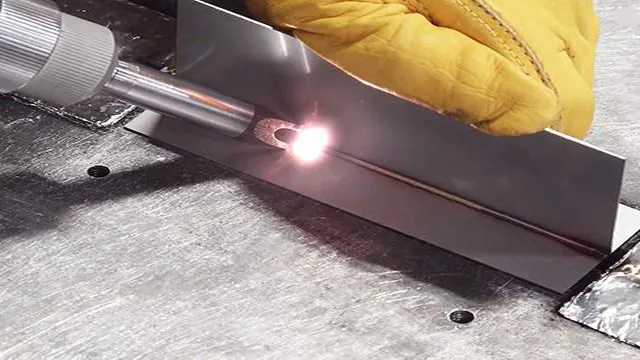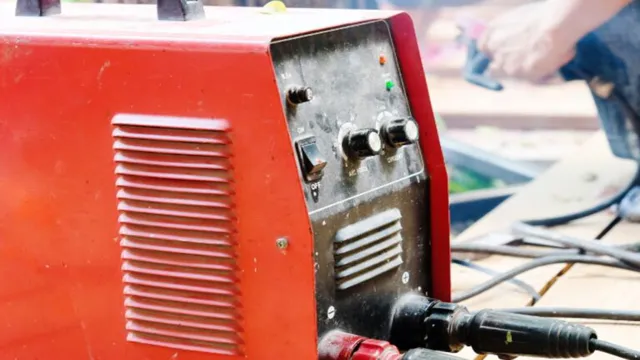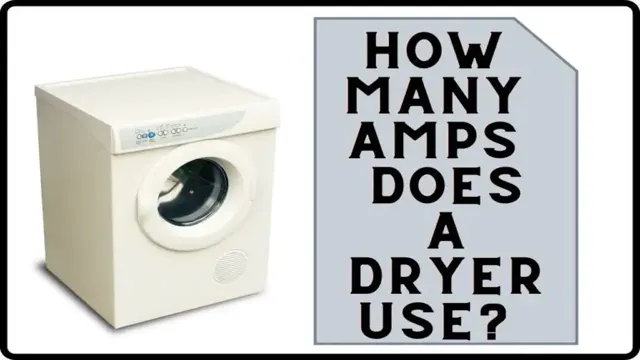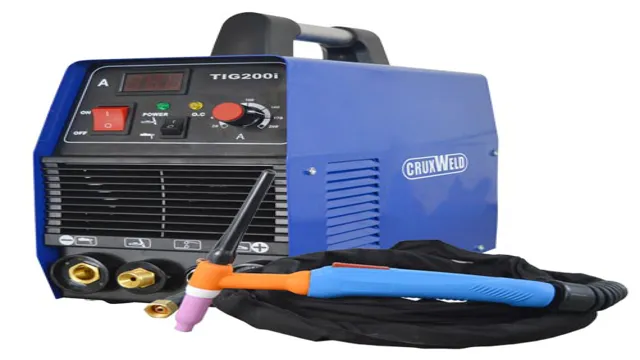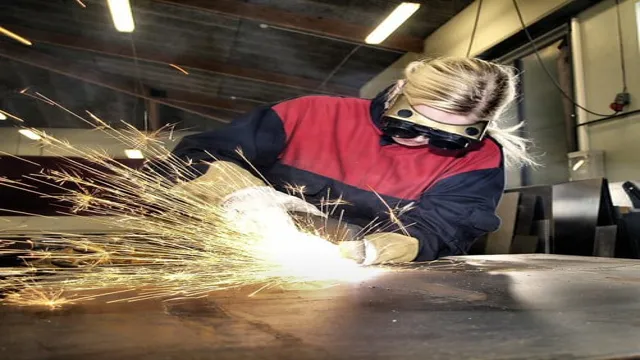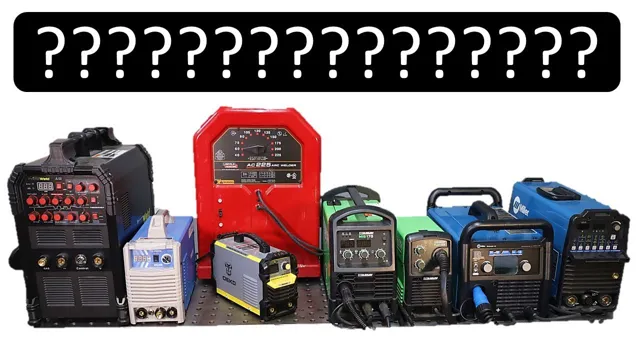How to See Through Welding Helmet: Tips and Tricks for Clear Vision

Welding is an important aspect in the metal fabrication industry, and the safety of welders is a top priority. One of the most important pieces of equipment for welders is the welding helmet. However, with the helmet on, it can be difficult to see the work being done.
This can create safety hazards and result in poor quality work. So, how can you see through a welding helmet? Firstly, it’s important to ensure that your welding helmet is designed with a high-quality lens that provides clear visibility. This lens should also have a good shade range that can be adjusted according to the type of welding being done.
Another important factor to consider is the lighting in your workspace. Poor lighting conditions can make it difficult to see through a welding helmet even with a good lens. So, ensure that your workspace is properly lit to make it easier to see your work.
Lastly, some welding helmets come with additional features such as a magnifier lens or a pivot lens that can be flipped up to provide a clear view when needed. These features can make it easier to see through your helmet and ensure you’re able to complete your work safely and effectively. In conclusion, seeing through a welding helmet can be challenging, but with the right equipment and proper workspace lighting, it is possible to ensure clear visibility.
By taking the necessary precautions, welders can work safely and confidently while wearing their helmets.
Understanding Welding Helmets
Learning how to see through a welding helmet takes some practice, but once you get the hang of it, it’s easy. Most welding helmets feature a darkening filter lens, which automatically adjusts the level of darkness according to the intensity of the welding arc. This filter lens effectively blocks out the bright light and harmful UV rays, ensuring that our eyes are protected while we work.
However, when the lens is in its darkened state, it can be challenging to see clearly – especially if you’re just starting. The key to seeing through a welding helmet is to position yourself correctly, adjust the helmet’s settings, and ensure that there is enough ambient light around you. It also helps to choose a welding helmet with a wide viewing area, providing a better field of vision.
Remember, always prioritize safety and invest in a good-quality welding helmet to protect your vision while welding.
Types of Welding Helmets
Welding helmets are essential safety gear for any welder. They protect the eyes and face from intense light and heat produced during the welding process. There are various types of welding helmets available in the market, and each has its unique features and benefits.
The most common type is the standard welding helmet, which is equipped with a fixed shade lens that protects the user from UV and infrared rays. Another type is the auto-darkening welding helmet, which comes with a lens that automatically adjusts the shade level based on the welding arc. This type of helmet provides better visibility and comfort to the users.
Some newer models also feature a grind mode that allows the helmet to be used for grinding operations as well. A third type is the respirator welding helmet, which combines the features of a welding helmet and a respirator mask. It protects the welder from harmful fumes, dust, and particles produced during the welding process, making it an ideal choice for those who work in enclosed spaces or with hazardous materials.
Regardless of the type of welding helmet you choose, it is crucial to ensure that it is comfortable, durable, and meets safety standards. By doing so, you can enjoy safe and efficient welding operations without worrying about the dangers posed by intense heat and light.

Choosing the Right Lens Shade
When it comes to welding, it’s imperative that you prioritize safety to avoid any accidents and injuries. One of the most crucial pieces of safety equipment for a welder is the welding helmet. A welding helmet provides protection to your face, eyes, and neck from the heat, sparks, and UV/IR rays during the welding process.
Choosing the right lens shade for your welding helmet is just as important as everything else in the welding process. The lens shade is essential to protect your eyes from the intense bright light produced during welding. The higher the lens shade number, the darker it is, which means more protection from harmful light rays.
So, it’s crucial to choose a lens shade that corresponds to the type of welding you’ll be doing, whether it’s MIG, TIG, or stick welding. The recommended lens shade number for MIG and stick welding is 10 to 14, while TIG welding requires a darker shade range of 8 to 13 to provide ample protection. Therefore, having the right lens shade for your welding helmet is vital to ensure the utmost safety while welding.
Tips on Seeing Through Your Welding Helmet
If you’ve ever tried to see through a welding helmet, you know it can be a tricky task. But with a little practice, you can learn how to see better through your helmet to improve the quality of your welding work. One of the first things to do is to adjust the lens shade on your helmet to prevent eye strain.
You can also try changing the angle of your helmet or using an anti-fogging solution to keep your lens clear and smear-free. Additionally, you can try using a battery-powered LED light, which can be mounted onto your helmet for better visibility. All these tips and tricks can go a long way in helping you see through your welding helmet, allowing you to focus more clearly on your welding work and produce better results overall.
Adjusting Your Welding Helmet Settings
When it comes to welding, adjusting the settings on your welding helmet is essential for safe and effective welding. But it’s also crucial to set your helmet in a way that allows you to see clearly. The first step to achieving this is making sure that your lens shade setting is appropriate for the current welding procedure.
Too dark or light a shade can interfere with your vision and result in burns or injuries. You may also want to experiment with the sensitivity and delay settings to ensure that the helmet reacts quickly to light changes and doesn’t blind you in the process. Taking the time to make these adjustments may seem tedious, but it can significantly improve your welding performance and safety.
Don’t be afraid to seek advice from other welders or professionals if you’re unsure about your helmet settings.
Clearing Your Welding Helmet Lens
Clearing your welding helmet lens is crucial to ensure clear vision while working on your welding project. The lens can become cloudy due to the accumulation of weld spatter, dust, and dirt. It can be frustrating to weld with a dirty lens because it can obscure your vision and affect the quality of your work.
One effective way to clean your helmet lens is by using a soft, clean cloth to wipe it gently. You can also use a specialized lens cleaning solution that can remove tough stains and scratches on the lens. Another tip is to remove the lens periodically to clean both sides thoroughly.
Taking care of your welding helmet lens can go a long way in ensuring the success of your welding project.
Using a Magnifying Lens
When it comes to welding, seeing through your helmet is essential for safety and accuracy. However, it’s not always easy to get a clear view of your workpiece with just your welding helmet’s lens. That’s where a magnifying lens can come in handy.
These lenses, which can be attached to your helmet’s lens, can help you get a closer, clearer view of your work. One tip for using a magnifying lens is to adjust its position until the lens is centered over your eye. This will ensure that you get the best possible view of your work.
Additionally, be sure to use a lens with a magnification that suits your needs. Too much magnification can make it difficult to see everything you need to, while too little might not give you the level of detail that you require. By following these tips, you can get a better view of your welding work and ensure that you’re completing your tasks safely and accurately.
Maintenance and Care
If you’re someone who constantly welds, then it’s essential to ensure that your welding helmet is always in top condition. One common issue that welders face is a cloudy or obstructed lens, which can make it difficult to see and ultimately impact the quality of their work. Thankfully, there are some easy steps you can take to prevent this problem.
Firstly, ensure that your helmet is always clean and free from any debris or scratches. You can use a soft microfiber cloth and some mild soap to clean the lens and the helmet exterior. Additionally, it’s crucial to regularly inspect the lens and replace it if it’s damaged.
Investing in a helmet with an auto-darkening feature can also help to avoid lens damage and provide clear visibility. With just a little care and maintenance, you can keep your welding helmet in excellent condition and enjoy clear and sharp vision during your work.
Cleaning Your Welding Helmet Lens
As a welder, taking care of your welding helmet lens is crucial to ensure proper visibility when working. Regularly cleaning your lens can prevent it from being damaged or fogged up, allowing you to see your work clearly. To clean your welding helmet lens, you should first remove any debris or dust by using a soft-bristled brush.
Then, spray a specialized lens cleaner onto the lens and wipe it with a microfiber cloth. Avoid using abrasive materials or household cleaners, as these can scratch or damage the lens. It’s also essential to replace your lens if there are any cracks or major scratches that impact your vision.
By regularly cleaning and maintaining your welding helmet lens, you can ensure optimal visibility and safety when carrying out welding tasks.
Storing Your Welding Helmet Properly
When it comes to maintaining your welding helmet, proper storage is crucial. One of the best ways to protect your helmet is by keeping it in a dry, cool, and well-ventilated area. You should also avoid placing heavy objects on top of it to prevent any dents or damage to the protective lenses.
Additionally, it’s crucial to clean your helmet after every use using a soft brush or cloth to remove any debris or dust. It’s also essential to check the lenses regularly for scratches or cracks and replace them as needed. By taking these simple steps, you can extend the lifespan of your welding helmet and ensure that it provides optimal protection when you need it most.
So, make sure to store it properly and keep it in good condition to ensure your safety while welding.
Conclusion
If you’re tired of feeling like you’re welding in the dark, it’s time to learn how to see through your welding helmet like a pro. With a few simple steps, you’ll be able to enhance your visibility and precision while protecting yourself from harmful rays. Whether you’re a seasoned welder or just starting, this handy trick will help you see the light and shine bright like a diamond.
“
FAQs
What are the different filters used in welding helmets?
Welding helmets may have various types of filters, such as auto-darkening filters, passive filters, or fixed shade filters.
How do I know if my welding helmet is suitable for my welding application?
The welding helmet should comply with industry safety standards, and the lens shade should be appropriate for the specific welding application.
Can I wear prescription glasses under my welding helmet?
Some welding helmets are designed to accommodate prescription glasses, while others may require a special adapter or contact lenses.
How do I adjust the sensitivity of my auto-darkening welding helmet?
Many welding helmets have adjustable sensitivity settings, which can be accessed through the control panel or a remote control.
Can I use my welding helmet for other purposes like grinding or cutting?
Some welding helmets may have additional features, like grinding mode or cutting mode, which allow for use in grinding or cutting applications.
How do I maintain my welding helmet for optimal performance?
Regular inspection, cleaning, and calibration of the filters and other components of the welding helmet can help ensure its proper functioning.
What are some common issues with welding helmets, and how can I troubleshoot them?
Common issues may include lens fogging, insufficient or excessive filter shading, or battery failure. Troubleshooting steps may include checking the helmet’s ventilation, replacing the batteries, or resetting the filter settings.

